RBA Annual Conference – 2013 Central Bank Liquidity Provision and Core Funding Markets Grahame Johnson and Eric Santor[*]
1. Introduction
The global financial crisis can be divided into three distinct phases – Phase I: a contained banking crisis (July 2007 to August 2008); Phase II: financial system collapse and global recession (September 2008 to April 2009); and Phase III: euro area sovereign debt and banking crisis (April 2010 to December 2012). In this paper, we examine how the evolution of the financial crisis can be explained from the perspective of a system-wide liquidity shock that hit funding markets in both the conventional banking and market-based financing (or shadow banking) sectors. While a significant shock to any of the broader funding markets would be likely to have negative economic implications, there is a subset of markets (the core funding markets) that lie at the centre of the financial system for which shocks of sufficient magnitude could have potentially catastrophic consequences. Given their centrality to the financial system, it was the runs in these core funding markets that defined the crisis. Subsequently, it was the policy interventions by central banks in these markets, complemented by the actions of the fiscal authorities, that allowed the recovery to take hold.
From this experience, it is clear that central banks need to continue to ensure that core funding markets remain functional at all times. This means that central banks need to be prepared, if necessary, to assume a key role in core funding markets in times of severe financial stress. In effect, the central bank's lender of last resort function must be extended to core funding markets. This commitment, however, must be balanced by measures to address moral hazard, protect taxpayer resources, and ensure the efficient functioning of markets in normal circumstances. To this end, we offer a vision for this role in the evolving global financial system.
The paper proceeds as follows. We first describe the three phenomena that contributed to the crisis: leverage, financial globalisation, and inadequate financial regulation and supervision. In Section 3, we examine the shadow banking system and market-based funding. This is followed by the definition of core funding markets in Section 4. Their centrality to the financial crisis is then explored in Section 5. Section 6 examines the role of central banks in core funding markets during the crisis, and Section 7 gives some examples of these actions. Section 8 concludes with a discussion of the future role of central banks in core funding markets.
2. The Global Financial Crisis: Preconditions for a Run on Financial Markets
An extensive literature has examined the underlying causes of the global financial crisis, with respective studies identifying a range of potential factors (Obstfeld and Rogoff 2010). Broadly speaking, in our view, the global financial crisis was fed by three self-reinforcing phenomena: a 30-year secular increase in leverage, financial globalisation, and, driven by a search for yield, excessive risk-taking in a context of inadequate regulation and supervision (Carney 2011).
2.1 Leverage
The first phenomenon was the seemingly unprecedented accumulation of debt over the past 30 years in the advanced economies (Figure 1).[1] Household debt rose dramatically, doubling over the period and surpassing 100 per cent of GDP in some cases, while corporate debt rose by close to 50 per cent. Likewise, government debt more than doubled as a share of GDP over the period (Cecchetti, Mohanty and Zampolli 2011). While government leverage was in some cases falling in the run-up to the crisis, this improvement in public finances was misleading – in fact, many countries were building significant structural deficits that were obscured by artificially strong pre-crisis growth.
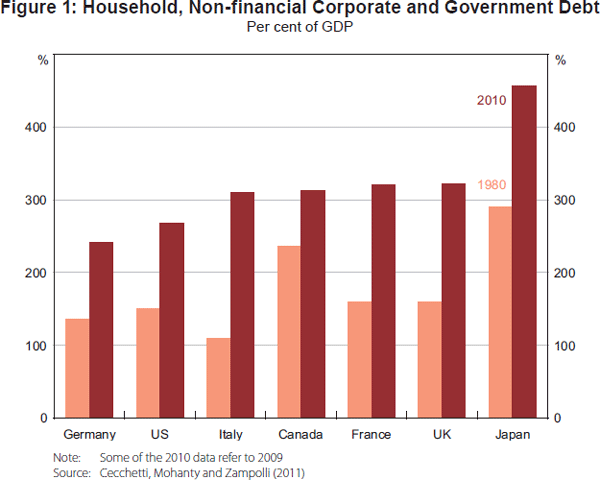
2.2 Cross-border lending
The second phenomenon was the ongoing globalisation of finance. Since the 1970s, capital flows have increased at roughly twice the rate of growth of trade (which has typically increased at twice the rate of growth of GDP), with a particular acceleration in the lead up to the crisis. Importantly, this increase in capital flows often took the form of cross-border lending by banks, much of it in foreign currency (McGuire and von Peter 2009). Between 2000 and 2007, claims on non-residents rose from roughly US$6.5 trillion to more than US$19 trillion (Figure 2).
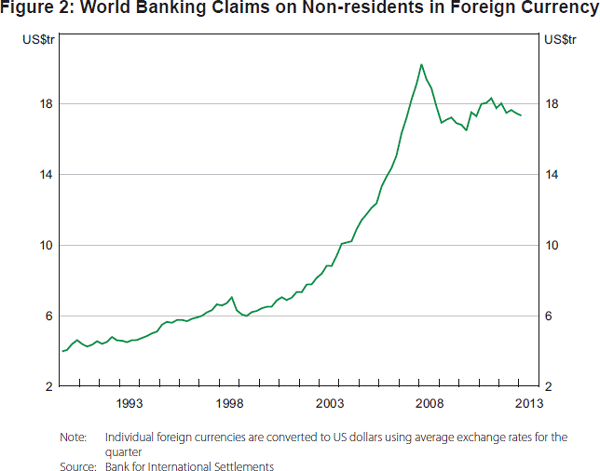
In particular, cross-border lending expanded rapidly in the euro area, as the apparent end to exchange rate risk led to substantial capital flows and a compression of spreads. This led to large imbalances, and some peripheral countries accumulated deficits in their net international investment positions of close to 100 per cent of GDP.
This increase in private capital flows was matched by a complementary increase in ‘public capital flows’ in the form of reserve accumulation, as many emerging market economies (EMEs) pursued export-led growth strategies (Figure 3). This uphill flow of capital from EMEs to the advanced economies helped to suppress long-term interest rates in the United States (and perhaps elsewhere), resulting in a subsequent search for yield by investors in the advanced economies (Bernanke 2005).

2.3 Financial regulation and supervision
The increase in leverage and cross-border exposures was made possible by a third phenomenon – rapid financial innovation and risk-taking in an environment of inadequate regulation and lax supervision. The search for yield in an environment of ‘low for long’ interest rates contributed to the demand for, and creation of, a range of complex structured products. These products included a set of ‘AAA-rated’ financial instruments based on pools of subprime mortgages, called collateralised debt obligations (CDOs). These CDOs typically contained different ‘tranches’, which reflected the underlying credit risk contained in the pool of assets. CDOs had three main features that would contribute to the severity of the crisis (Brunnermeier 2009).[2]
- Originate to distribute. Historically, banks offering loans would typically hold these assets on their balance sheet. However, by securitising a pool of loans and selling it as a CDO, a bank could off-load the risk onto other investors (this would also reduce the need to hold capital against these assets). These investors were, in principle, better placed to handle this risk. The main problem with this model is that it lowered the incentives for the bank to screen the quality of the borrowers, as it would not bear the risk. This behaviour contributed to a dramatic decline in lending standards. At the same time, the complexity and opacity of CDO structures meant that investors were often purchasing assets about which they understood very little. Driven by a search for yield, investors were assuming higher risk (even if this was not entirely clear at the time). In many cases, demand for these assets came from foreign investors, who in fact had the perception that these assets were ‘safe’ (Bernanke 2011).
- Maturity transformation. CDOs and other types of securitisation often utilised a funding model that relied on maturity transformation. In this case, special purpose vehicles were set up such that longer-term assets (such as a pool of subprime mortgages in the form of a CDO) were funded by shorter-term paper. Credit lines were established by the sponsoring bank as ‘liquidity backstops’ in case there were difficulties in rolling over the short-term paper (Brunnermeier 2009). The result was a funding model that relied excessively on short-term funding.
- Capital and the repo market. Since many CDOs were held ‘off-balance’ sheet, they required little or no capital. Those CDOs that were in the pipeline to be sold were also, often inappropriately, generally given very high credit ratings (Jaffee et al 2009). These high credit ratings allowed the underlying assets to be used in the repo market as a source of funding. The net effect was that banks were able to increase their leverage, and held far too little capital given the underlying risks to the balance sheet. These three features of CDOs were a key factor behind their rapid expansion – between 2000 and 2007, CDO issuance in the United States rose rapidly (Figure 4), constituting a growing part of the overall market for asset-backed securities (ABS).
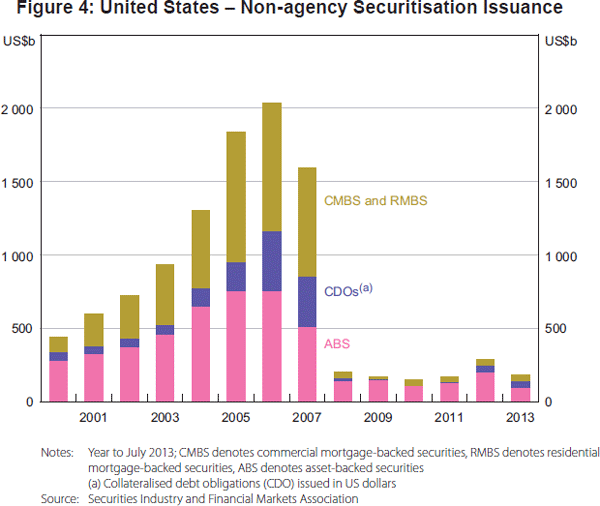
When combined with the larger trends of leveraging, globalisation and lax supervision and regulation, the issuance of CDOs contributed to both the severity and persistence of the crisis. When the first indications that subprime mortgage-backed securities were going to incur losses, the impact was amplified considerably for several reasons:
- The opacity of the CDO structure meant that it was effectively impossible for investors to determine which CDOs held ‘bad’ assets and which were generally sound. This information asymmetry problem contributed to the collapse of the entire CDO market.
- Ongoing integration of global financial markets meant it was particularly unclear which financial institutions held similar types of debt – and thus fears about counterparty risk were global, not just domestic.
- Counterparty risk was compounded by inadequate regulation and supervision – bank leverage was extremely high and capital buffers were insufficient given the scale of losses.
- As doubt was cast on the value of subprime-related assets, the problem was quickly amplified and cascaded. Falling collateral values led to the impairment of the repo market.
- As the repo market became impaired, collateralised funding for a range of markets dried up forcing fire sales, further depressing asset prices.
- In many cases, funding was in foreign currency (European banks funding CDOs with short-term US dollar paper) which compounded the impairment in funding markets.
As risk was rapidly and brutally repriced through the global financial system, financial markets faced ‘runs’ of an unprecedented nature, spanning both the conventional banking sector and the shadow banking sector. In particular, it was the runs in the core funding markets that led to the failure of many financial institutions in the second half of 2008. Likewise, it was the subsequent intervention by central banks and fiscal authorities in these markets that forestalled a complete collapse of the financial system. The crisis did not end in 2009, however, as the imbalances that had built up in the euro area still needed to be unwound. Again, the stresses caused by the resolution of these imbalances would emerge in core funding markets. In what follows, we examine more closely the shadow banking sector and its relationship to core funding markets.
3. Shadow Banking and the Role of Market-based Funding
The shadow banking sector facilitated many of the developments highlighted above that led to the financial crisis, especially the increase in system-wide leverage and the prevalence of subprime-related CDOs. The Financial Stability Board (FSB) describes shadow banking as ‘credit intermediation involving entities and activities outside the regular banking system’ (FSB 2012). In defining the shadow banking system, the FSB follows a two-step approach:
- look at all non-bank credit intermediation
- focus on the subset of non-bank credit intermediation where there are: (i) developments that increase systematic risk (maturity/liquidity transformation, imperfect credit risk transfer, and/or leverage); and/or (ii) indications of regulatory arbitrage.
In following this approach, the FSB uses an entity-based definition for its monitoring exercises. Specifically, the size of the shadow banking sector is based on assets held by ‘other financial institutions’ (OFIs), which are entities that lie outside of the traditional banking sector. This includes hedge funds, money market mutual funds, finance companies and structured investment vehicles. The key findings of the 2012 monitoring report are as follows:
- Globally, the shadow banking sector rose rapidly from US$26 trillion in 2002 to US$62 trillion in 2007. As the crisis hit, the size of the total market declined slightly in 2008 – however, it would soon expand again, and increased to US$67 trillion by 2011. The shadow banking system's share of total financial intermediation has decreased since the crisis, although it remains at around 25 per cent (after having peaked at 27 per cent in 2007).
- There is considerable divergence across jurisdictions in terms of the relative size of the shadow banking system, the range of activities undertaken and the growth trends. The shadow banking sector in the United States has one of the larger shares (35 per cent of total financial assets are held by OFIs), while the euro area (30 per cent) and the United Kingdom (25 per cent) are also relatively large. Germany's shadow banking sector is relatively small (15 per cent).
Under the entity-based definition, Canada's shadow banking system is relatively small (under 10 per cent of total financial assets). The entity-based measure, however, excludes shadow banking activities undertaken by banks that may, nonetheless, contribute to systemic risk. This is particularly relevant for a country like Canada, in which the large banks are the most significant participants in domestic capital markets.
An alternative is to use an activity-based approach, focusing on bank-like intermediation activities that are conducted primarily through financial markets. This approach captures such activities as repos and securitisations and thus provides a more accurate description of the relative importance of market-based funding activities for a given jurisdiction, particularly given the predominance of the banks in a number of these markets in Canada (Figure 5; Gravelle, Grieder and Lavoie 2013).
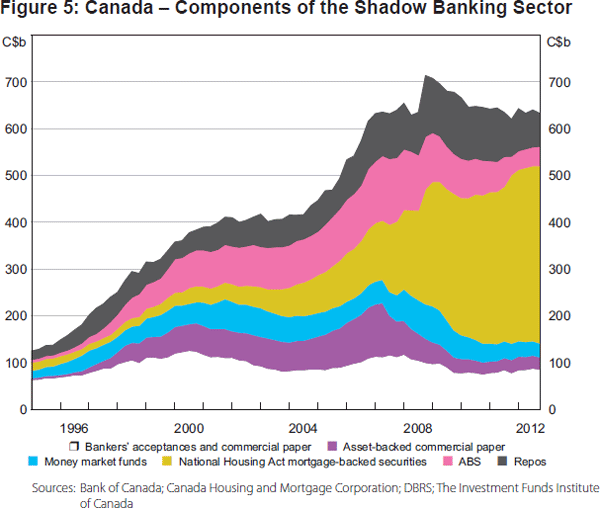
Under this definition, the size of shadow banking activity in Canada grew significantly in the period leading up to the financial crisis, reaching a level close to 60 per cent of the traditional banking sector (Figure 6). It has, however, subsequently declined and currently stands at roughly 40 per cent of the traditional banking sector's size. The size of the Canadian shadow banking sector is estimated to be roughly 40 per cent of GDP (compared with approximately 95 per cent for the United States).

While this approach focuses on activities rather than entities, it is consistent with the FSB approach in that it focuses on the extent to which shadow banking activities exhibit any or all of the following four risk factors:
- maturity transformation – long-term assets financed with short-term liabilities
- liquidity transformation – the underlying assets being financed are relatively illiquid
- leverage
- imperfect credit risk transfer – some credit exposure is held off-balance sheet or implicit support is provided by an entity.
The Canadian shadow banking sector is made up of five main subsectors:
- Government-backed mortgage securitisations (60 per cent).
- Private-label securitisations (10 per cent).
- Repurchase agreements (repos) (10 per cent).
- Money market mutual funds (5 per cent).
- Short-term unsecured debt (bankers' acceptances (BAs) and commercial paper (CP)) (15 per cent).
Each of these markets contains at least one of the four risk factors cited above, and could therefore be vulnerable to runs. In such markets, runs are generally triggered by information asymmetry. Specifically, a number of the underlying (securitised) products that support the shadow banking system lack full transparency. Opacity around the underlying assets that support securitisations can lead to valuation uncertainty. This greatly reduces the liquidity of the products, often making it impossible to roll over short-term financing for longer-term assets (impairing both the maturity and liquidity transformation functions). Furthermore, uncertainty about the distribution of underlying losses raises concerns about counterparty risks, which can lead to disruption in other shadow banking markets (such as repos and short-term unsecured debts). Under these circumstances, the shadow banking funding markets can freeze up and participants can become increasingly unwilling to deal with each other. Given the importance of these markets, such disruptions can lead to systemically important shocks, spreading to a range of other markets and institutions, ultimately affecting a far wider range of financial activities than the five sectors outlined above. This suggests a role for central banks in ensuring that the critical (that is, core) funding markets can operate continuously, even in times of extreme stress.
4. Identifying Core Funding Markets
There is a high level of interconnectedness between the shadow banking sector and the broader set of traditional financial markets and institutions (FSB 2012). In particular, the shadow banking system plays a large role in providing funding liquidity to both financial institutions and market makers. As such, a number of shadow banking activities could be considered systemically important in that shocks to these markets can spread to other financial markets and institutions. Moreover, there is a subset of markets that lies at the centre of the financial system for which such a shock would have catastrophic consequences. These core funding markets are necessary to the process of generating liquidity within the financial system itself. If one of them disappeared, there would be no substitute for its function. They therefore need to function continuously (Carney 2008a; Fontaine, Selody and Wilkins 2009).
Financial institutions and other market participants use core funding markets for two main purposes. First, these markets allow the funding of temporary mismatches between financial inflows and outflows, providing necessary operating liquidity for financial institutions to function. Second, core funding markets allow market makers to finance long positions and cover short positions. This supports transactions across the full range of financial markets and supports broad market liquidity. A failure of core funding markets, generated either through liquidity hoarding by counterparties or a reduction in market-making activity, could result in a ‘liquidity spiral’ (Brunnermeier and Pedersen 2009), creating a generalised liquidity crisis.
More formally, the Bank of Canada has defined a core funding market as having the following three characteristics (Fontaine et al 2009):
- It is an important source of funding for the institutions, market makers and governments at the centre of the financial system.
- There is no immediate substitute for this funding source.
- If the market ceases to function, there is likely to be important contagion between major institutions and markets.
Given that the specific structure of financial systems varies across time and jurisdictions, the specific core funding markets will vary accordingly. Nonetheless, it is unlikely that there would be much variation in core funding markets across the major advanced economies.
Given this definition, the Bank of Canada has identified the following five markets as core.
- Sovereign debt (Government of Canada bonds and treasury bills). The sovereign debt market is at the core of the financial system in most countries. This market provides the necessary funds that the federal/central government, which is the ultimate guarantor of the stability of the financial system, needs to operate. As well, in most jurisdictions, sovereign debt plays a critical role in financial markets, being used as a pricing reference, a hedging vehicle, a liquidity management tool in the banking system and a risk-free asset. There is no substitute for this market, and any material disruption would have severe consequences for the financial system.
- Repo markets. These markets provide collateralised funding and are used extensively by market participants (both banks and shadow banking entities) to finance their inventories of securities. Repo markets are central to the ‘securitised banking’ system (Gorton and Metrick 2009), and dislocations (or runs) in this market result in a massive withdrawal of liquidity from the financial system.[3]
- Securities lending. While relatively small in size, securities lending markets facilitate a range of financing activities for both the cash and repo markets. As well, securities lending facilitates the efficient use of collateral within the financial system.
- Unsecured private money markets. Not all private sector unsecured markets are (or should be) core and, in Canada, this designation would only apply to the market for BAs. BAs are used by both banks and their clients for short-term liquidity management. Importantly, BAs can also substitute for both CP and asset-backed commercial paper (ABCP).
- Foreign exchange. Both spot and foreign exchange swap markets are core markets, as without them neither domestic financial institutions with foreign liabilities nor international institutions with Canadian dollar liabilities would be able to manage their funding activities. This would force these institutions into their domestic markets, potentially forcing them to fund foreign assets with domestic borrowings. There is no substitute for the ability to transact in foreign exchange (FX) markets. The FX market does represent a particular challenge, however, as domestic authorities are constrained in the amount of FX liquidity they can provide to their financial system.
For these core markets to function properly, they need adequate liquidity. Under normal circumstances, these markets endogenously generate sufficient liquidity such that they can operate efficiently and effectively with no external support. These markets are, however, vulnerable to shocks. Large shocks, either endogenous or exogenous, can lead to ‘runs’ in these core markets. Under these circumstances, keeping core funding markets continuously open requires appropriate policies and interventions, including central bank support.
5. Runs in Core Funding Markets
The increases in leverage, cross-border lending and rapid financial sector innovation were intimately tied to developments in the provision of market-based funding. The vulnerabilities arose not only from the size and scope of the shadow banking activities themselves, but also from the high degree of interconnectedness between the shadow banking system and both the broader financial markets and the traditional banking system. Banks and shadow banking (both entities and activities) are highly interconnected, with banks often playing a large role (either directly or indirectly) in the shadow banking credit intermediation chain. One of the key lessons emerging from the crisis is that shocks originating in the shadow banking sector can quickly propagate to core funding markets and institutions.
Due to this degree of interconnectedness, the sharp declines in the value of US subprime mortgages and the associated securitisations were quickly transformed into a system-wide shock, spreading to a broad range of market-based funding markets, both structured and traditional. Ultimately, the crisis led to the loss of market access for a number of European sovereigns. Indeed, the financial crisis has been referred to as a ‘system-wide bank run’, with the only difference between this event and prior bank runs being that it largely took place outside of the traditional banking sector (Gorton and Metrick 2009). The results were, however, very similar. Funding liquidity vanished as markets froze and counterparties became increasingly reluctant to transact with each other, almost irrespective of the quality of collateral being used to support the activities. This was equivalent to a massive withdrawal of liquidity from the financial system due to the impairment of core funding markets. In what follows, we highlight how core funding markets behaved during the respective phases of the crisis.
5.1 Phase I: July 2007 to August 2008
The first signs of the coming crisis emerged in mid 2007, as several funds exposed to subprime mortgage-based CDOs were suspended or frozen (Brunnermeier 2009), leading to losses at several banks. As these losses were reported, concerns about counterparty risk emerged, leading to a direct impact on prices in core funding markets. LIBOR-OIS spreads in a number of jurisdictions rose to roughly 100 basis points (Figure 7) from the previously suppressed levels of less than 10 basis points. Since many of the affected banks were based in Europe, tensions began to appear in the foreign exchange market as seen in the TED spread (Figure 8) and FX swap rates (Figure 9). Concerns about counterparty risks also appeared in other funding markets. For example, CP rates increased (Figure 10) and, as tension in the repo market affected the ability to fund other forms of ABS, auto and consumer debt ABS prices fell (Figure 11).
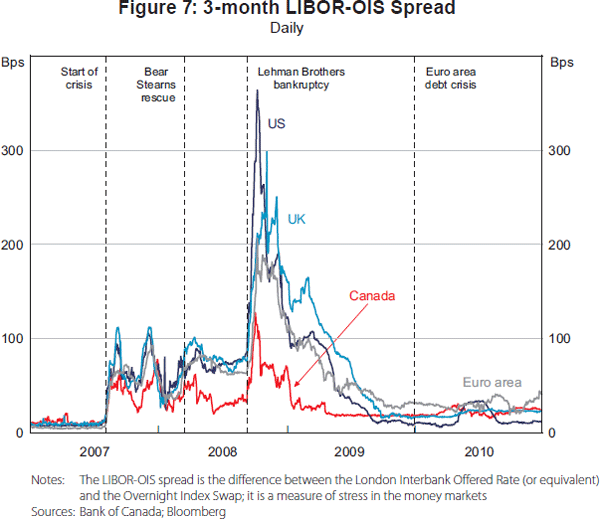
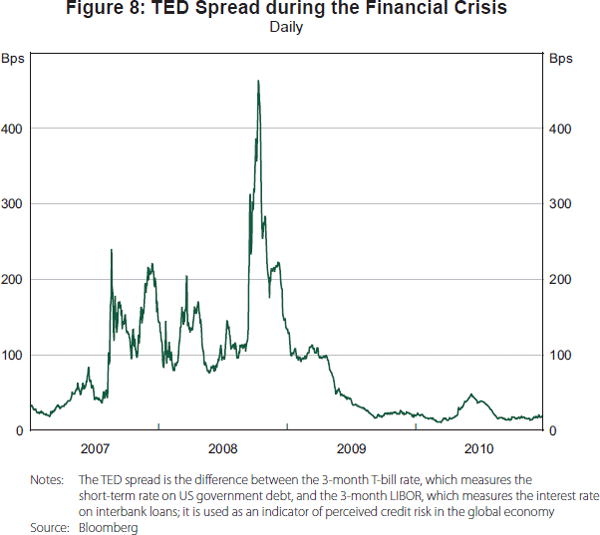

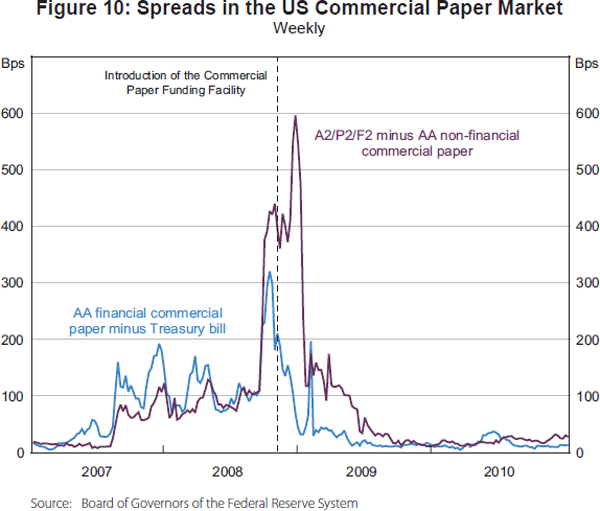
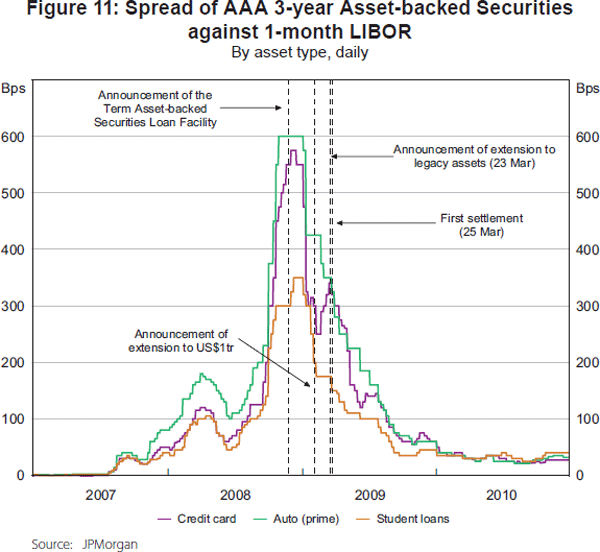
While the respective core funding markets suffered shocks, the run remained relatively contained through the first half of 2008. Although markets were stressed and banks were reporting large subprime-related losses, funding markets remained sufficiently liquid due to two main factors. First, the major central banks introduced measures to ease tensions in the key interbank markets (e.g. the Federal Reserve's Term Auction Facility (TAF) program; and the European Central Bank's (ECB's) open market operations (OMOs)). Second, the Fed supported the purchase of Bear Stearns by JPMorgan, which seemingly reassured markets that no large systemically important bank would be allowed to fail.
While the crisis appeared to remain contained through the first half of 2008, this state of affairs did not last for long. Despite ongoing growth in the global economy, the United States entered a recession and housing market activity and prices continued to decline. The underlying imbalances in the financial system had not been rectified, and further losses could be expected. These tensions came again in full force as Lehman Brothers lurched towards insolvency in early September 2008. However, it would not be bailed out.
5.2 Phase II: September 2008 to April 2009
The subsequent failure of Lehman Brothers in mid September 2008 led to a massive run in most core funding markets, but on a scale far beyond that experienced earlier in the year. Interest rates in a number of funding markets, both core and ancillary, rose sharply, as seen in LIBOR-OIS spreads, CP interest and FX swap rates, and rates on other forms of ABS (Figures 7 to 11). Likewise, quantities became severely impaired, as many banks were shut out of these markets and resorted to central bank facilities when possible. At the same time, pressures in the US dollar market became acute for many European banks, as evidenced by very sharp moves in both EUR/USD basis swaps and the TED spread.
These stresses and dislocations spread to other markets. Stress in US repo markets deepened, as evidenced by the increase in spreads between agency (and agency mortgage-backed securities) repo rates relative to general collateral (Copeland, Martin and Walker 2011). Likewise, money market mutual funds (MMMFs) started to experience massive outflows after one fund ‘broke the buck’ (Figure 12). These flows were only staunched in response to interventions by the US Federal Reserve and US Treasury.
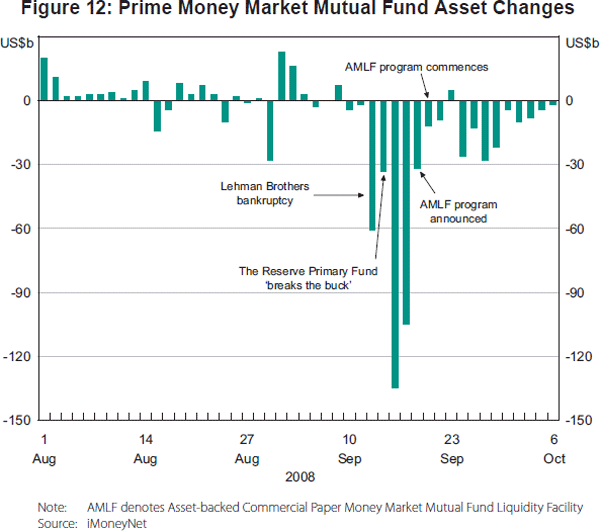
As the financial crisis deepened towards the end of 2008, the real economy also faltered, and sharp declines in activity were registered across most advanced economies as credit dried up and confidence was severely shaken. The inability of the financial system to provide funding for real activity was due to the failure of core funding markets. Subsequently, it was only the concerted actions of policymakers that prevented the Great Recession from becoming something even worse (see Section 6).
5.3 Phase III: April 2010 to December 2012
While European interbank markets were also severely affected, the inherent flexibility of the ECB's OMOs (and related collateral policy) appeared to be successful in mitigating some of the worst aspects of the crisis for European core funding markets. Moreover, since shadow banking was less prevalent in the euro area, the damage to what constituted the ‘core funding markets’ was less severe. However, the impact of the risks was merely delayed.
In early 2010, revelations that Greece's fiscal position was much worse than reported led to a sharp increase in its bond yields, and contagion to other peripheral bond market spreads as their fiscal positions came into question (Figure 13).
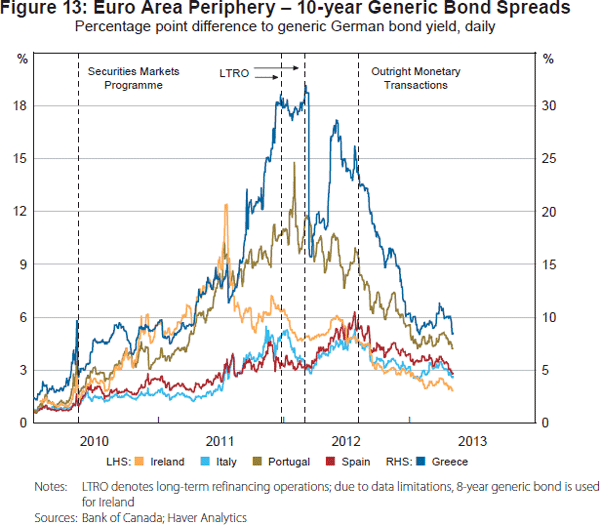
This stress in the core funding markets for peripheral sovereigns was reinforced by a concurrent deterioration in funding markets for peripheral banks as counterparty risk concerns emerged (Figure 14).
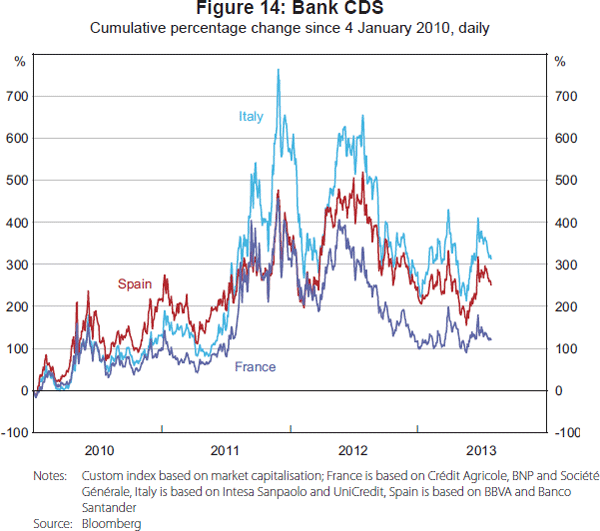
A negative feedback loop developed, in which impairment in the banking sector fed concerns about sovereign solvency. But as banks were major holders of sovereign debt, their balance sheets came under pressure. The results were twofold:
- Peripheral sovereigns were either shut out of their own ‘core’ funding markets and had to turn to the International Monetary Fund (IMF)/European Union (EU) for a program for financing, or were (eventually) implicitly backstopped by the establishment of the European Financial Stability Facility (EFSF)/European Stability Mechanism (ESM) and the ECB's Securities Markets Programme (SMP)/Outright Monetary Transactions (OMT).
- Peripheral banks were effectively shut out of the core unsecured funding market, and instead had to rely heavily on the lending facilities of the ECB, as seen in TARGET2 imbalances (Figure 15).
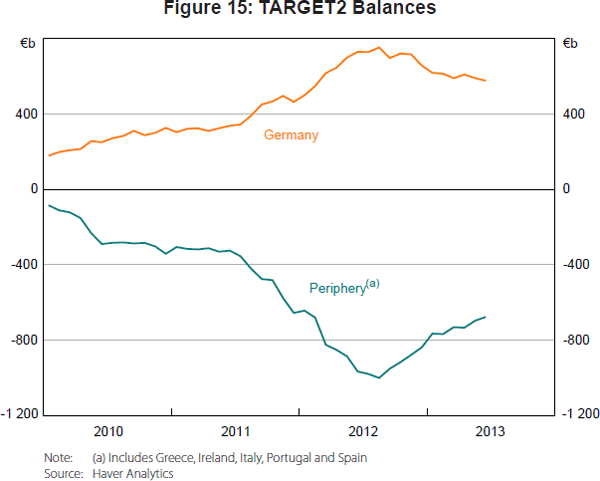
As funding dried up, credit to the private sector was significantly impaired – this in turn contributed significantly to the recession that began occurring in the euro area in the fourth quarter of 2011. Moreover, the run on core funding markets in the euro area – specifically sovereign and bank funding markets – even sparked concerns about the integrity of the euro area itself, further undermining confidence. While subsequent measures, such as the OMT and progress towards the banking union, have effectively reduced this risk, core funding markets had not yet returned to ‘normal’.
6. Central Bank Support of Core Funding Markets
As discussed above, the recent crisis has clearly shown that financial markets, including those that we would define as core funding markets, are vulnerable to runs. These runs are triggered by large, systemic shocks, and manifest themselves as a severe lack of liquidity in which, at the extreme, markets freeze altogether as participants are unwilling to transact with each other at any price. Simply, the private sector generation of funding liquidity shuts down.
Liquidity shortages can be broken down into three distinct categories (Cecchetti and Disyatat 2010).
- The first is a shortage of central bank liquidity, in which specific institutions find themselves short of central bank reserve balances. This can be due to either a distributional problem within the system or an aggregate shortage of central bank reserves (due to, for example, a sudden increase in demand for central bank money for precautionary purposes). In either case, this liquidity shortage manifests itself through upward pressure in the overnight interest rate, with generally little risk that the dislocation spreads to other markets. This is the most benign type of liquidity shock, and can generally be addressed using standard OMOs.
- The second is an institution-specific shortage of funding liquidity. This is generally associated with idiosyncratic, counterparty-specific solvency concerns. These are best dealt with using institution-specific (as opposed to market-wide) support.
- The third, and most relevant for this paper, is a system-wide shortage of funding liquidity. A shortage of funding liquidity of this nature typically arises from a negative shock to confidence among market participants. Such a shock to confidence is generally due to incomplete or asymmetric information, either with regard to asset valuations or counterparty creditworthiness. Such uncertainty can lead to a break down across a number of key markets, including those defined as core funding markets. The result is a collapse in the private sector generation of funding liquidity.
It is the third type of liquidity shortage that is the most disruptive to the broader financial system (and, by extension, the real economy). Funding liquidity is critical to the efficient and stable functioning of the financial system as a whole, including the effective transmission of monetary policy. As such, disruptions in core funding markets have material consequences for the real economy. Given central banks' price stability objectives, as well as their responsibilities to support the safety and efficiency of the financial system, they clearly should have an interest in ensuring that these markets function continuously, especially in times of stress. As the ultimate provider of domestic liquidity to their respective financial systems, central banks are uniquely placed to support these markets during times of extreme stress. This means that, when the private generation of funding liquidity shuts down, central banks should be prepared to extend their lender of last resort role to key funding markets, even becoming a ‘market-maker of last resort’ if required (Carney 2008a).
There are a number of problems that can lead to vulnerabilities in core funding markets, potentially leading to a system-wide funding liquidity shock. The first is incomplete or asymmetric information about counterparty credit risk, asset valuations, or both. The resulting increase in uncertainty often leads to a sharp increase in risk aversion on the part of the private sector participants, a reduced amount of trading activity, and an associated decline in liquidity. The second is weak market infrastructure. Poorly designed or fragile market infrastructure can actually magnify risk when the system is placed under stress. Consider, for example, a highly interconnected OTC derivative network with insufficient margining practices. Stress in one institution can quickly magnify and be transmitted to the entire system. Finally, a weak or inappropriate regulatory regime, including capitalisation levels that are too low, can significantly undermine the stability of core funding markets.
Given the nature of these problems, policies to strengthen and support the private generation of liquidity in core funding markets can take a number of forms.
- Improvements in market infrastructure. These policies can take two main forms. The first is the promotion of sound and robust clearing and settlement processes, including the creation of central counterparties (CCPs) where appropriate. Robust and risk-proofed CCPs can greatly diminish the risk that weakness in one participant in a core market will magnify and transmit to other participants. The second is the creation and support of more standardised and transparent financial instruments. Product standardisation and increased transparency reduces information asymmetry surrounding asset valuations, which should help support liquidity during times of stress.
- Strengthening the regulatory framework. Improvements in the current regulatory framework, both for the banking and shadow banking sectors of the economy, can reduce the incentives for inappropriate risk-taking, increase transparency as to the financial strength of counterparties, and ensure that market participants hold a sufficient degree of liquidity. Improvements in accounting standards can ensure that all participants have access to an appropriate level of information on their counterparties, while reducing mechanistic reliance of credit rating agencies can foster a wider range of analysis and opinions on credit conditions.
- Increasing the capitalisation of key market participants. The increased capital charges resulting from the Basel II.5 and Basel III frameworks will result in better capitalised, more stable financial market participants. The associated decline in counterparty risk should have a material impact on reducing counterparty credit concerns and supporting the core funding markets.
These changes, all of which are currently in various stages of implementation, will enhance the resilience of the private generation of liquidity in core funding markets during times of stress. Nonetheless, even upon the successful implementation of all of these structural changes, there still may be times when relying solely on the private sector provision of funding liquidity is insufficient. A large shock to the financial system could still generate an aggregate demand for liquidity that is greater than the capacity of the private financial system to generate endogenously. It is in these circumstances that it would be necessary for a central bank to intervene, supporting those core funding markets that are not functioning properly and ensuring the sufficient provision of system-wide funding liquidity. The nature of this liquidity provision should, however, depend on the nature of the shock that has hit the financial system.
A central bank has three types of tools that it can use to support core funding markets (Cecchetti and Disyatat 2010).
- Direct lending to financial institutions. This approach is appropriate when a single financial institution is facing a liquidity shock. Providing funding support to the institution can prevent an idiosyncratic shock from becoming a systemic one. If the liquidity shock is a shortage of central bank liquidity, this assistance is generally provided through standing facilities (e.g. the Bank of Canada's Standing Liquidity Facility). In the event there is a chronic shortage of funding liquidity for a specific institution, however, this form of central bank support is generally provided by facilities such as Emergency Lending Assistance (Canada) or Emergency Liquidity Assistance (euro area and the United Kingdom). This is one of the traditional lender-of-last-resort roles played by central banks. It focuses on specific institutions rather than markets, and will not be addressed further in this paper.
- Lending or borrowing in the open market. This type of intervention is conducted through either repo-type operations (pledging of securities for cash) or securities lending (pledging less-liquid securities for more-liquid securities) and can be used to change the distribution of liquidity within the financial system when the private sector allocation of liquidity is no longer efficient. Private sector institutions may exit repo funding markets due to concerns (or lack of information) regarding either the creditworthiness of their counterparties or the valuation of the underlying collateral. Exit can either be complete (refusal to transact with a given counterparty or using a certain type of collateral) or partial (sharp increases in the haircuts applied to collateral values, even for high-quality assets). These types of operations provide liquidity enhancement or liquidity transformation services to the market – the central bank takes liquidity risk on its balance sheet by replacing liquidity-impaired assets in the private sector with unquestionably liquid assets (generally cash or government securities). The central bank is uniquely placed to perform this service in times of stress, as it is the only market participant that cannot face liquidity constraints.
- Outright purchases and sales of assets. This type of intervention is used by some central banks as a standard means of implementing monetary policy through adjustments in the aggregate level of liquidity in the market.[4] In the context of this paper, however, we refer to the financial stability purposes in which the central bank may target quasi-permanent liquidity injections in specific markets as a means of encouraging the endogenous generation of liquidity. Operations for these purposes are generally more controversial than lending operations, as they (by design) have a direct impact on market prices. As well, they expose the central bank to a larger amount of risk. While lending/borrowing operations remove liquidity risk from the financial system, outright purchases and sales of assets remove either duration risk, credit risk, or FX risk (depending on the market targeted) from the private sector and place them on the central bank balance sheet.
The implementation of any of these tools raises moral hazard issues. It is likely, however, that such moral hazard concerns are less relevant for systemic liquidity shocks. These shocks represent a market failure that has been prompted by an aggregate liquidity shock that is not likely to be due to the assumption of broad-based government support by institutions or participants. Nevertheless, the market-wide fragilities that made the system vulnerable to such shocks in the first place may have been exacerbated by the failure of individual institutions to build up sufficient liquidity and capital buffers against such an event. This could be, in part, due to expectations of central bank support in times of crisis.
Given this, while central bank support of core funding markets during times of stress is necessary, the interventions should be structured so as to mitigate, as much as possible, the risk of any unintended consequences. The best way to accomplish this is to follow a structured, principled approach to implementation. Towards this end, the Bank of Canada has identified the following five principles that guide our provision of extraordinary liquidity and any interventions in core funding markets (Carney 2008b; Zorn, Wilkins and Engert 2009).
- Target those distortions of system-wide importance. Interventions, particularly non-standard or exceptional measures, should be focused on system-wide disruptions of core markets. Central bank actions should not be used to mitigate or manage price volatility across non-core markets. As well, a central bank should only attempt to mitigate those market failures that it is best placed to rectify. Specifically, this means that interventions should generally be concentrated on liquidity disruptions, which central banks are best placed to address.
- Intervention should be graduated. The strength and nature of the intervention should be commensurate with the breadth and magnitude of the disruption. Relatively minor liquidity dislocations can be addressed through the use of standard tools and the addition of liquidity through traditional channels (e.g. the provision of overnight liquidity through regular counterparties). As the severity of the stresses increases, the nature of the intervention should change accordingly. More widespread liquidity problems may warrant a more aggressive response. At the extreme, the breakdown of a core funding market may require direct intervention (market maker of last resort) by the central bank.
- Intervention tools must be well designed. Intervention programs should be carefully designed to address the specific market failure and focused on the specific core markets where the distortions are observed. For example, for some relatively minor market failures, the simple existence of a central bank backstop at a (slightly) penal rate may be sufficient to restart the endogenous liquidity generation process. If the issue is a shortage of high-quality collateral, on the other hand, the central bank may need to engage directly in collateral transformation operations. Finally, the most severe market disruptions are likely to require direct intervention.
- Minimise unintended market distortions. By design, central bank interventions in core funding markets are intended to have a price and activity impact. Ideally, the intent is to get better alignment between actual market conditions with the price and activity level that would exist if the private sector generation of liquidity were functioning properly. Interventions should, however, be carefully designed to minimise any unintended effects beyond the initial goal. As a general rule, transactions should, to the extent possible, take place at market-determined prices and conditions. This can usually be facilitated through the use of an auction mechanism to allocate liquidity. In this way, the price of liquidity is determined by market participants and not by the central bank. Competitive auctions have another benefit – the simultaneous and anonymous participation of a wide range of participants in the operation can help minimise any stigma associated with the operation. As well, to the extent possible, facilities should be designed to preserve existing market structures. In many cases, this would mean using the traditional market makers as counterparties.
- Mitigate moral hazard. Measures beyond those detailed above that could help mitigate the risk of moral hazard include the use of time-limited interventions, appropriate pricing and the promotion of sound supervision of liquidity risk management. The use of time-limited programs helps to ensure that market participants do not permanently change their behaviour. Appropriate pricing of operations can help ensure that central bank interventions have a natural and market-determined end date. While pricing must be cheaper than is available in the market at times of stress, it should be more expensive than market pricing during normal circumstances. In this way, the facilities become self-liquidating. Once market conditions improve, participants will automatically migrate away from the use of the intervention facilities. Sound supervision can help ensure that participants maintain (or build) appropriate liquidity risk management frameworks even in the presence of central bank interventions.
7. Case Studies: Three Central Bank Interventions
The global financial crisis provided a number of examples of central bank support of core funding markets. These operations had a broad range in terms of the markets they focused on, the market failure they were intended to address, their design and ultimate effectiveness. This section will review three operations, from three different central banks, targeting three distinct core funding markets, that were (or are) consistent with the criteria described above and have proven successful in addressing the market failure they were targeted at.
7.1 Canada: Term purchase and resale agreements
Driven by a combination of heightened funding pressures in other markets and a freeze in Canada's non-bank ABCP market, stresses in the short-term funding markets for Canadian banks began to mount significantly in the second half of 2007. The growing dislocation in these funding markets was evidenced by sharp increases in the costs of banks' short-term funding relative to the expected path of the overnight rate (as proxied by the CDOR-OIS spread).[5]
The initial widening in the CDOR-OIS spread, which took place in August 2007, was relatively minor, with the 3-month CDOR-OIS spread widened from a historical average of about 7 basis points to over 40 basis points. At that time, the Bank of Canada limited its market interventions to the use of the standard overnight facility (conducting special purchase and resale agreements (PRAs) and adjusting the level of settlement balances). This initially appeared to be sufficient, as bank funding spreads declined through October and November. The situation worsened going into year-end, however, and funding spreads began to widen. To address the renewed pressure, the Bank of Canada announced the term PRA facility, providing longer-term collateralised funding to a select group of market participants.[6]
The initial term PRA operations were relatively modest in size – consisting of two auctions of C$2 billion each and with maturities of less than one month (Figure 16). The operations were wound down in January 2008, and reinstated in March 2008 when funding pressures re-emerged. From March until May 2008, the Bank of Canada rolled 1-month operations, keeping the amount outstanding at C$4 billion, and let the facility wind down again by July as conditions improved.
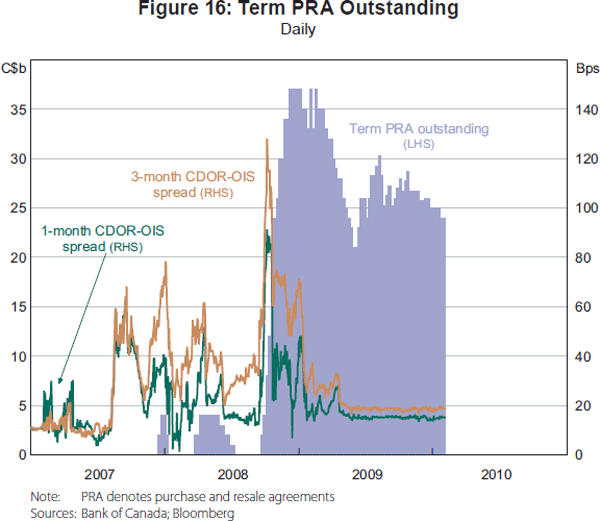
Funding conditions deteriorated very sharply in late 2008, with the 3-month CDOR-OIS spread reaching levels in excess of 120 basis points. Given that Canada had one of the most stable and well-capitalised banking systems in the world at the time, the fact that short-term funding pressures moved so sharply is indicative of the risks of contagion to the core funding markets. The Bank of Canada responded by materially expanding the scope of the term PRA operations. The size of the operations was materially increased (the maximum size reached C$12 billion), the frequency of operations was increased from biweekly to weekly, the range of eligible counterparties was expanded to include all primary dealers and all members of the domestic payment system, and the range of acceptable collateral was expanded. The outstanding amount of term PRA peaked at C$37 billion.
As shown in Figure 16, bank funding spreads declined fairly rapidly following this more aggressive implementation of the term PRA program. While care should be taken in attributing all of this improvement to the Bank of Canada's interventions, there is convincing evidence that term PRA announcements had both transitory and persistent effects on reducing the liquidity premium in bank funding costs (Enenajor, Sebastian and Witmer 2010).
The design and implementation of the term PRA facility over this period is judged, therefore, to have been a success. It is consistent with the five principles outlined in Section 6. It was designed to target distortions of system-wide importance (a sharp and broad-based increase in bank funding costs). Its implementation was graduated, becoming larger and more aggressive as the circumstances warranted. The interventions were also targeted directly at bank funding conditions, with minimal impact on other markets. Market distortions were minimised through the use of a competitive auction process for pricing – the allotment yield was determined by how aggressively the participating institutions bid. The Bank of Canada, therefore, was a price taker, not a price setter. Finally, steps were taken to mitigate the risk of moral hazard. As conditions improved, the Bank of Canada gradually reduced the size, term and frequency of the operations, halting operations on 12 April 2010.[7]
7.2 Central bank foreign exchange (FX) swap lines
A FX swap is the simultaneous purchase and sale of identical amounts of currency with two different value dates (a spot and forward transaction). For large banks with significant foreign currency assets, this market provides a critical means of accessing foreign currency funding. The basis represents the cost difference between borrowing in the domestic currency or using a combination of borrowing in the foreign currency and using spot and FX forward transactions. Arbitrage should generally ensure that the basis stays relatively close to zero.
Prior to the crisis, a number of foreign banks (particularly European institutions) had built up large US dollar-denominated asset positions. While the funding of these positions came from a range of sources, the FX swap market represented one of the largest. As the crisis worsened, however, many of these banks began to have severe difficulties accessing the FX swap market. By late 2008, for example, the 3-month EUR/USD implied basis hit levels of approximately 300 basis points. This means that a European institution that could borrow at 3-month Euribor had to pay LIBOR plus 300 basis points to transform that into US dollar funding. Similar stresses were evident across other currency pairs (including JPY/USD and GBP/USD). For institutions with large amounts of US dollar assets that needed funding, this represented an extremely severe funding problem. To address this issue, the US Federal Reserve and a number of other central banks instituted central bank swap lines, whereby the Federal Reserve made US dollars available to other central banks (swapped in exchange for the participating central bank's domestic currency). The participating central banks, in turn, made the US dollars available to their domestic institutions that were facing US dollar funding shortages.
Usage of the central bank swap facilities peaked at almost US$600 billion (or roughly 25 per cent of the size of the Federal Reserve's balance sheet) in late 2008 and early 2009 before falling to zero in early 2010. Usage of the facility picked up again in late 2011 following the escalation of the European sovereign debt crisis. Evidence suggests that these reciprocal swap lines were successful in alleviating funding pressures in the FX market. Take-up by foreign institutions was very large and the announcement (and execution) of swap operations was associated with improved conditions in those markets. Empirical research generally supports this view (see, for example, Baba and Packer (2009) and Coffey et al (2009)).
Similar to the Bank of Canada's term PRA program, the design and implementation of the FX swap facilities can be viewed as a successful program to support a core funding market. It targeted distortions of system-wide importance. The program was graduated, starting off relatively small before expanding. The interventions were targeted; they focused exclusively on providing short-term US dollar funding (in exchange for foreign currency) to institutions that required it. Market distortions were minimised through a combination of the pricing mechanism (the swaps were priced below the rates that prevailed during stressed conditions, but well above normal market conditions) and the auction mechanisms that were used to allot the US dollars. Finally, the program was structured to minimise moral hazard. By being priced at a penalty rate relative to normal market conditions, the programs were self-liquidating. When conditions improved, the level of participation fell.
7.3 Outright Monetary Transactions (OMT) program
As the sovereign debt crisis in Europe escalated over the period of early 2010 to July 2012, a number of European sovereigns progressively lost market access. Greece effectively lost access to market funding in early 2010 and, by May 2010, euro area countries and the IMF agreed to a €110 billion aid package. Following this decision, the EFSF was created by the euro area member states. The EFSF's stated mandate was to safeguard financial stability in Europe by providing financial assistance to euro area member states. It was intended to provide a backstop to sovereign funding markets, providing financing to those vulnerable sovereigns who had lost market access under their own name. The EFSF was created as a temporary mechanism, and in December 2010 the European Council took the decision to create a permanent facility, the ESM. The ESM, which came into force in October 2012, serves as a funding backstop for euro area sovereigns. These facilities did not represent central bank support of a core funding market. Rather, they were a fiscal backstop, and their ability to raise and distribute funds is based on sovereign guarantees (EFSF) or paid-in capital (ESM). As such, they are limited in the amount of support they can provide.
Following the Greek package, pressure began to mount on other European sovereigns that were seen to be vulnerable. In November 2010, Ireland effectively lost market access and needed a funding package from the EU/IMF totalling €85 billion. In May 2011, Portugal received a €78 billion funding package. In each of these three cases, the resources of the EFSF (and ESM) were sufficient to guarantee that the sovereign would receive the necessary funding. Of more systemic concern was the potential loss of market access for Italy and/or Spain. As Spanish and Italian yields moved sharply higher in mid and late 2011, concerns that these sovereigns might lose market access escalated. The size of these sovereign bond markets meant that support from the EFSF/ESM would be insufficient. Only a central bank could provide sufficient support to guarantee funding access. This raised fears about a euro area exit and led to an increasing systemic risk (or re-denomination risk) component in European sovereign bond yields (Klose and Weigert 2012).[8]
The ECB did act – announcing two 3-year long-term refinancing operations (LTROs) in December 2011. These operations provided participating banks unlimited term financing (against acceptable collateral) and were designed to break the negative feedback loop between weak sovereigns and their banking system. While the LTROs were identified as a ‘credit support measure to support bank lending and liquidity’ (ECB 2011), there was a strong market expectation that they were also intended to help stabilise sovereign debt markets, particularly for Spain and Italy. In this regard, there was some initial success – there was a sharp initial decline in the yields on Spanish and Italian debt (by roughly 150 to 200 basis points). The effect was relatively short-lived, however. While LTROs offered banks funding certainty, which was a desirable outcome in its own right, the design was not appropriate to serve as a direct backstop to sovereign funding markets. The intervention tool was not designed to specifically and directly target the core market failure (a sovereign loss of market access), and did not minimise market distortions (Mullineux 2012). Rather than break the negative feedback loop between the sovereign and the banking system, it strengthened it by encouraging banks to access the LTRO and use the proceeds to purchase sovereign debt. Finally, there were moral hazard concerns in the sense that the program had no real conditionality; it provided funding to banks (and, indirectly, sovereigns) with no incentive for behavioural change.
Consequently, the improvement in sovereign funding conditions was short-lived. A number of European sovereigns (Spain and Italy in particular) saw their yields begin to move sharply higher once again. Fears grew that both Spain and Italy would require some sort of funding assistance.
The ECB response to these renewed stresses was the OMT. While not specifically identified, the notion of direct ECB support for sovereign funding markets was raised in a speech by Mario Draghi in 2012 (see Draghi (2012)). Specifically, Draghi said that ‘[w]ithin our mandate, the ECB is ready to do whatever it takes to preserve the euro. And believe me, it will be enough’. While not providing specific details about the nature of the program, financial markets broadly interpreted this as a commitment that the ECB would support sovereign funding liquidity. The existence of a conditional ECB backstop was again raised at the 2 August 2012 ECB press conference and additional detail (including the name) around the OMT was provided in September 2012.
The impact of the OMT was significant. European sovereign bond yields began to fall immediately following the July speech. The outright level of yields, however, can be influenced by a variety of factors. More indicative of the success of the OMT was the decline in dispersion of government bond yields across euro area sovereigns (see Figures 17 and 18). This supports the hypothesis that country-level idiosyncratic risks (the ‘re-denomination risk’ of exiting the euro area) began to play less of a role, while a common ‘euro area’ interest rate factor became relatively more important.
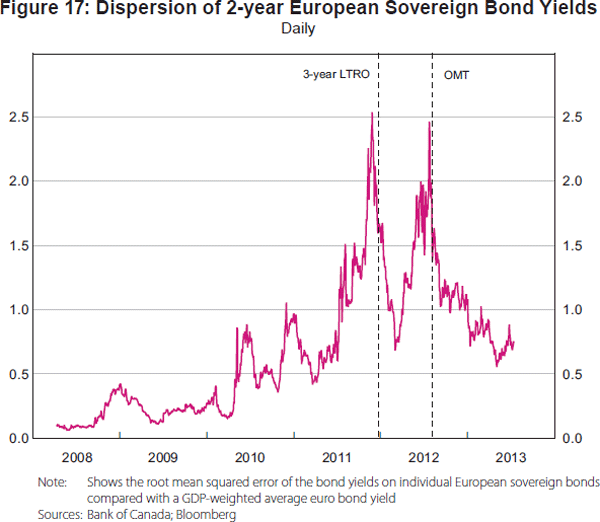
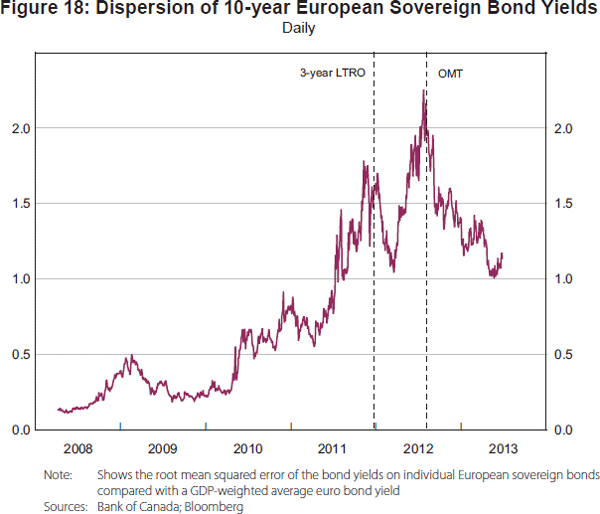
The OMT, while never actually having been activated, appears to have been successful at supporting euro area sovereigns' access to funding. As with the other programs reviewed, it is consistent with the five criteria discussed in this paper. It specifically targets a distortion of system-wide importance – sovereign funding markets. The intervention was graduated in the sense that the OMT followed a number of other programs (EFSF, ESM, LTROs) that were designed to address a more contained loss of sovereign funding access. Once it became clear that the problem was becoming increasingly widespread across the euro area, the OMT was introduced. The program was also well designed. It targeted the specific market failure directly and was of sufficient magnitude (essentially unlimited) that there was limited risk that the market could perceive the size of the program as insufficient. The OMT minimised unintended market distortions by remaining vague with regard to what it considered success. The objective of the OMT was never to bring the funding costs of all euro area sovereigns to a predetermined level (e.g. a very small spread to Germany), but rather to eliminate the yield premium that was associated with convertibility risk (the risk that the sovereign in question would re-denominate). As such, the market was uncertain as to what level the ECB saw as ‘fair value’ for a given sovereign (although it was generally assumed the fair value spread was significantly wider than the pre-crisis levels). Finally, the OMT took steps to mitigate moral hazard. Specifically, a necessary condition for an OMT intervention is the strict conditionality associated with an EFSF/ESM program (or a precautionary conditioned credit line). The presence of these conditions makes accessing the OMT a relatively unattractive option for a sovereign.
8. Conclusion
The preconditions for the global financial crisis and the subsequent global recession were established through the combination of a widespread increase in leverage, the ongoing growth in cross-border financing, and excessive risk-taking in an environment of inadequate regulation and supervision. The trigger was, however, a sharp decline in the value of US subprime mortgages and the associated securitised assets that held them. This led to a system-wide liquidity shock that spread to a range of funding markets. Funding liquidity vanished as a range of financial markets froze and it was only the timely and aggressive actions of authorities, including central banks, that prevented the near-total collapse of the financial system.
While the propagation of such a massive liquidity shock to the broad financial system would have significant effects on the real economy, there is a subset of funding markets that lie at the centre of the financial system and for which such a shock could have catastrophic consequences. These core funding markets are critical to the generation of liquidity within the financial system. The Bank of Canada has identified five such markets – sovereign debt, the repo market, securities lending, unsecured short-term bank debt and foreign exchange. These markets have no substitutes and, as such, they need to be continuously open.
A key lesson from the financial crisis is that, while these core funding markets need to be continuously open, they can be subject to runs if hit by a system-wide shock of sufficient magnitude. In these cases, the central bank must be prepared, under the appropriate conditions, to expand its lender-of-last-resort duties to support these markets. This support can come from a wide range of programs, including standing facilities, liquidity backstops, and direct market interventions. While the specific details of the support mechanism are dependent on the particular circumstances, effective central bank support of core funding markets should be targeted, graduated and well designed. The programs should be structured in such a way as to minimise market distortions, mitigate moral hazard and protect taxpayer resources. These principles will help the programs achieve their desired goals and minimise the chances of unintended consequences. There were a number of such programs undertaken by central banks over the crisis, with varying degrees of success. The more successful ones, however, all met the criteria outlined above.
The crisis has clearly shown that, given the growth and importance of market-based financing, central bank support of the core funding markets needs to be permanently available (although not permanently active). Authorities (including central banks), therefore, must take a more system-wide approach to monitoring, assessing and addressing vulnerabilities within the global financial system, both in traditional banking and shadow banking activities. The lender-of-last-resort function needs to be expanded to include support of core funding markets, with the central bank being a ‘market maker’ of last resort if necessary. The responses in the height of the crisis were by necessity ad hoc. Central banks should, however, take advantage of the lessons of the crisis to structure appropriate programs for the future. This entails identifying which markets are core for each jurisdiction, establishing monitoring and assessment capabilities to identify when those markets are under significant stress, and structuring effective support programs that minimise the likelihood of unintended consequences.
Footnotes
The views expressed here are those of the authors and are not necessarily those of the Bank of Canada. [*]
There are many reasons why debt has increased relative to incomes over the past three decades, including financial development (deepening and broadening), and lower economic volatility and interest rates due to the Great Moderation. [1]
Another contributing factor was that prior to the crisis, housing prices had not fallen on a national basis in the United States since data had been collected. Consequently, earlier vintages of subprime loans, when defaults did occur, did not result in losses for banks, as rising house prices meant that the collateral value of the house would offset any potential losses. Markets failed to account for this effect when assessing the losses given default on subprime mortgages. [2]
There is a significant amount of literature (e.g. Gorton 2009) that cites a run on certain parts of the repo market in the United States as the link that led from losses in the market for US subprime mortgages to a global financial and economic crisis. [3]
These operations typically involve purchases and sales of short-term government securities as a means of adjusting the aggregate level of central bank reserves. [4]
CDOR stands for the Canadian Dealer Offered Rate and is the rate at which dealers will purchase BAs issued in the primary market. It can be seen as largely analogous to the LIBOR rate. OIS stands for the overnight indexed swap. [5]
The term PRA operations were conducted exclusively with primary dealers for Government of Canada securities. [6]
In early 2009, term PRAs began to be used as a monetary policy tool as well as a liquidity facility. Specifically, on 21 April 2009 the Bank of Canada lowered the target for the overnight rate to the effective lower bound (25 basis points) and made a commitment to keeping the overnight rate at this level until the second quarter of 2010, conditional on the outlook for inflation. To reinforce this commitment, the Bank of Canada conducted 6- and 12-month term PRAs with minimum and maximum bid rates set to the target (25 basis points) and the bank rate (50 basis points), respectively. [7]
For an example of the increasing market concerns about redenomination, see Cameron (2012). [8]
References
Baba N and F Packer (2009), ‘From Turmoil to Crisis: Dislocations in the FX Swap Market Before and After the Failure of Lehman Brothers’, BIS Working Paper No 285.
Bernanke BS (2005), ‘The Global Saving Glut and the U.S. Current Account Deficit’, Remarks at the William A Sandridge Lecture at the Virginia Association of Economists 32nd Annual Meeting, Richmond, 10 March.
Bernanke BS (2011), ‘International Capital Flows and the Returns to Safe Assets in the United States, 2003-2007’, Banque de France Financial Stability Review, 15, pp 13–26.
Brunnermeier MK (2009), ‘Deciphering the Liquidity and Credit Crunch 2007-2008’, The Journal of Economic Perspectives, 23(1), pp 77–100.
Brunnermeier MK and LH Pederson (2009), ‘Market Liquidity and Funding Liquidity’, The Review of Financial Studies, 22(6), pp 2201–2238.
Cameron M (2012), ‘Dealers Tackle Euro Redenomination Risks’, Risk online, 6 February. Available at <http://www.risk.net/risk-magazine/feature/2141921/dealers-tackle-euro-redenomination-risks>.
Carney M (2008a), ‘Building Continuous Markets’, Remarks to the Canada-United Kingdom Chamber of Commerce, London, 19 November.
Carney M (2008b), ‘Principles for Liquid Markets’, Remarks to the New York Association for Business Economics, New York, 22 May.
Carney M (2011), ‘Global Imbalances: The International Monetary System and Financial Stability’, Banque de France Financial Stability Review, 15, pp 31–38.
Cecchetti SG and P Disyatat (2010), ‘Central Bank Tools and Liquidity Shortages’, Federal Reserve Bank of New York Economic Policy Review, 16(1), Special Issue: Central Bank Liquidity Tools and Perspectives on Regulatory Reform, pp 29–42.
Cecchetti SG, MS Mohanty and F Zampolli (2011), ‘The Real Effects of Debt’, BIS Working Paper No 352.
Coffey N, WB Hrung, H-L Nguyen and A Sarkar (2009), ‘The Global Financial Crisis and Offshore Dollar Markets’, Federal Reserve Bank of New York Current Issues in Economics and Finance, 15(6), pp 1–7.
Copeland A, A Martin and M Walker (2011), ‘Repo Runs: Evidence from the Tri-Party Repo Market’, Federal Reserve Bank of New York Staff Report 506, rev March 2012.
Draghi M (2012), ‘Verbatim of the Remarks made by Mario Draghi’, Speech given at the Global Investment Conference, London, 26 July.
ECB (European Central Bank) (2011), ‘ECB Announces Measures to Support Bank Lending and Money Market Activity’, Press Release, 8 December.
Enenajor E, A Sebastian and J Witmer (2010), ‘An Assessment of the Bank of Canada's Term PRA Facility’, Bank of Canada Working Paper 2010-20.
Fontaine J-S, J Selody and C Wilkins (2009), ‘Improving the Resilience of Core Funding Markets’, Bank of Canada Financial System Review, December, pp 41–46.
FSB (Financial Stability Board) (2012), ‘Global Shadow Banking Monitoring Report 2012’, 18 November.
Gorton GB (2009), ‘Information, Liquidity, and the (Ongoing) Panic of 2007’, The American Economic Review, 99(2), pp 567–572.
Gorton GB and A Metrick (2009), ‘Securitized Banking and the Run on Repo’, NBER Working Paper No 15223.
Gravelle T, T Grieder and S Lavoie (2013), ‘Monitoring and Assessing Risks in Canada's Shadow Banking Sector’, Bank of Canada Financial System Review, June, pp 55–63.
Jaffee D, AW Lynch, M Richardson and S Van Nieuwerburgh (2009), ‘Mortgage Origination and Securitization in the Financial Crisis’, in VV Acharya and M Richardson (eds), Restoring Financial Stability: How to Repair a Failed System, John Wiley & Sons Inc, Hoboken, pp 61–82.
Klose J and B Weigert (2012), ‘Determinants of Sovereign Yield Spreads During the Euro-Crisis – Fundamental Factors Versus Systemic Risk’, German Council of Economic Experts Working Paper 07/2012.
McGuire P and G von Peter (2009), ‘The US Dollar Shortage in Global Banking and the International Policy Response’, BIS Working Paper No 291.
Mullineux A (2012), ‘The Eurozone Crisis: Escaping the “Doom Loop”’, unpublished manuscript, University of Birmingham, November.
Obstfeld M and K Rogoff (2010), ‘Global Imbalances and the Financial Crisis: Products of Common Causes,’ in R Glick and MM Spiegel (eds), Asia and the Global Financial Crisis, Asia Economic Policy Conference sponsored by the Federal Reserve Bank of San Francisco, San Francisco, pp 131–172.
Zorn L, C Wilkins and W Engert (2009), ‘Bank of Canada Liquidity Actions in Response to the Financial Market Turmoil’, Bank of Canada Review, Autumn, pp 3–22.